뇌종양(腦腫瘍) Brain tumor
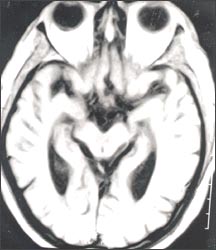
사진 3-1. 뇌 전후면 MRI
Copyright ⓒ 2012 John Sangwon Lee, MD., FAAP

사진 3-2. 뇌 측면 MRI 사진
Copyright ⓒ 2012 John Sangwon Lee, MD., FAAP
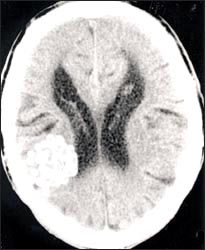
사진 3-3. 뇌 CT 검사
Copyright ⓒ 2012 John Sangwon Lee, MD., FAAP
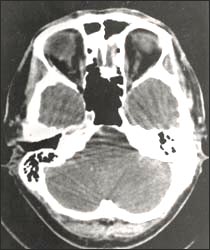
사진 3-4. 좌 대뇌에 난 뇌종양
Copyright ⓒ 2012 John Sangwon Lee, MD., FAAP
뇌종양의 원인
- 대부분의 뇌종양의 원인은 아직 확실히 모른다.
- 신경 피부 증후군이 있을 때 여러 종류의 종양이 중추 신경계 중 대뇌에 날 수 있다.
- 뇌에 양성 종양도 날 수 있고 악성 종양(암)도 날 수 있다.
- 첫 돌 전 영아들에게 뇌종양이 날 수 있고, 그 이후 유아들이나 학령기 아이들, 어느 연령층 아이들에게도 생길 수 있다.
- 그렇지만 뇌종양은 5~6세 유아들에게 더 잘 난다.
- 뇌의 어떤 특정 부분에 종양이 났을 때 양성 종양이든 악성 종양이 든 종양의 증상 징후가 더 심하게 나타날 수 있다. 그런 양성 종양을 절제수술 치료하는 데 더 어려움이 있을 수 있다.
- 소뇌 성상세포종 등은 소뇌에 더 많이 난다.
- 뇌에 생긴 어떤 병을 방사선으로 치료하거나, 선천성 뇌 기형, 신경섬유종, 또는 다른 종류의 신경피부 증후군이 있을 때 뇌종양이 날 가능성이 더 많다.
- 소뇌에 가장 많이 생기는 뇌종양은 성상세포종이다.
- 수모세포종, 뇌간교종상 세포종, 천막상 종양, 두개인두종 등 여러 종류의 뇌종양이 있다.
뇌종양의 종류
- 양성 뇌종양과 악성 뇌종양
- 수모세포종,
- 뇌간교종상 세포종,
- 천막상 종양,
- 두 개 인두종
- 성상세포종
- 신경섬유종
뇌종양의 증상 징후
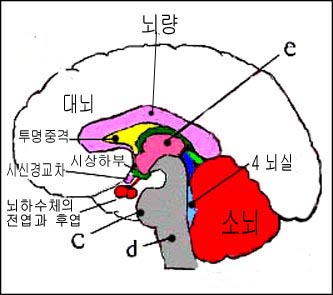
그림 3-7. 뇌 측면 그림
a- 대뇌, b- 소뇌, c- 뇌교, d- 연수, e- 3뇌실
참조문헌; Gray’s Anatomy

그림 3-8. 뇌 저 전후면 그림
1~12는 12 쌍의 뇌신경의 기시부
a- 대뇌, b- 소뇌, c- 뇌교, d- 연수
참조문헌; Gray’s Anatomy
- 악성 종양, 양성 종양, 종양의 종류, 종양이 난 뇌 부위, 종양의 크기, 뇌종양의 진행 정도 등에 따라 증상 징후가 다르다.
- 뇌종양의 종류에 관계없이 뇌에 종양이 나면 두통·구토·마비·경련 등은 공통적 증상 징후이다.
- 뇌종양으로 사시, 복시, 운동실조 등의 증상 징후가 나타날 수 있다.
- 아직 말로 증상을 잘 표현 할 수 없는 영유아들에게 뇌에 종양이 나면 머리가 아프다고 말로 표현할 수 없다. 그들에게 울고 보채며 칭얼대는 등의 증상 징후가 생길 수 있다.
- 잠을 비정상적으로 많이 자거나 못자거나 잘 먹지 않거나 힘없이 축 늘어지기도 한다.
- 서서히 자라는 뇌 종양으로 성장발육이 지연될 수 있고 소화기계 질병으로 구토할 수 있다.
- 특히 아침에 잠자리에서 일어나서 몸과 머리를 움직이기 시작 할 때 머리가 아프고 심하게 구토할 수 있다.
- 뇌 종양이 점점 커지면서 머리가 점점 아프게 된다.
- 뇌 종양이 있는 뇌 부위에 따라 증상 징후가 다르다. 뇌의 어떤 부위에 뇌 종양이 생겼느냐에 따라 시력·청력·후각·보행·언어·행동 등의 장애가 생길 수 있다.
- 뇌 종양으로 뇌척수액 순환 통로의 일부가 차단되면 수두증이 생기기도 하고 머리통이 비정상적으로 커지기도 한다.
- 전신경련을 일으킬 수도 있다.
- 수두증 참조
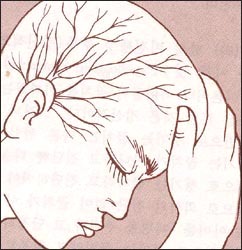
그림 3-5. 뇌 ct 스캔
뇌종양으로 인한 두통은 밤낮 가리지 않고 생기고 날이 갈수록 더 심해지고 열은 나지 않고
구토 등의 증상을 동반하는 것이 보통이다.
Copyright ⓒ 2012 John Sangwon Lee, MD., FAAP
뇌종양의 진단
- 병력, 증상 징후, 진찰소견 등을 종합하여 뇌종양이 있다고 의심하면, 뇌 CT 검사, 뇌 MRI 검사, 기능적 뇌 MRI 검사, 뇌파검사, 뇌 초음파 검사, 뇌 X-선 검사, 뇌실검사로 진단할 수 있다.
뇌종양의 치료
- 뇌 종양이 생긴 뇌 부위, 양성 종양인지 악성 종양인지, 뇌종양의 종류, 뇌종양의 진행 과정 등에 따라 치료가 다르다.
- 뇌 종양이 대뇌 속 깊숙이 나 있으면 그 뇌 종양이 양성 뇌 종양이든 악성 뇌 종양이든 뇌 종양을 수술 제거 치료를 하기가 어렵다.
- 뇌 종양이 대뇌 주요 부분에 나 있으면 그 뇌 종양을 수술로 제거하기가 어려울 수 있다.
- 대부분의 뇌 종양은 수술 제거치료·항암제 치료·방사선치료 등으로 쉽게 치료된다.
- 그러나 어떤 악성 뇌 종양은 다른 악성 종양보다 치료가 잘 되지 않는다.
|
다음은 의식불명이 되어 병원에 입원했는데, 뇌혈관이 터졌다고 하네요에 관한 인터넷 소아청소년 건강상담 질의응답의 예 입니다. |
Q&A. 의식불명이 되어 병원에 입원했는데, 뇌혈관이 터졌다고 하네요
Q.
- 10월 5일 네시경 저의 아들인 소완이(7세)가 동네 문방구 앞에서 자기보다 조금 큰 아이에게 머리를 맞고 뇌에 출혈이 있어 근처의 한림대성심병원(안양)으로 옮기니 가망없다고 합니다.
- 또 씨티사진을 찍어본 결과 뇌종양도 발견됐습니다. 의사선생님은 뇌종양의 혈관이 터졌다고합니다. 첨에는 전혀 반응과 호흡이 없었으나 수술 후 숨이 돌아왔고 이제는 약간의 반응이 있으나 여전히 의식이 없습니다.
- 주위에서는 중앙병원이니 삼성의료원이니 영동세브란스니 병원을 옮기라고 말들을 합니다. 지금 옮겨도 좋은 건지 옮길 때 위험하다는 소리도 들었습니다.
- 마냥의식이 깨어나길 기다리자니 답답하고 종양이 걱정됩니다. 어떡하면 좋을까요?
A.
- 연님
- 안녕하세요. 좋은 질문해 주셔서 감사합니다.
- 자녀의 나이, 성별, 과거 병력, 가족 병력, 진찰소견, 임상검사 등의 정보를 많이 알수록 답변을 드리는데 도움이 됩니다. 주신 정보를 토대로 해서 답변을 드리겠습니다.
- 컴퓨터 이상으로 답이 늦었습니다. 지금 쯤 많이 회복됐을 줄 믿습니다.
- 뇌종양에는 여러 종류가 있고 뇌종양의 종류에 따라 증상 징후, 치료, 예후가 다릅니다.
- 병원을 옮기는 문제는 담당 의사와 상의해 결정하는 것이 좋습니다.
- 의식회복은 수술부위와 수술의 정도에 따라 차이가 있습니다.
- 질문이 더 있으시면 다시 연락해 주시기 바랍니다.
- 소완이의 건강 회복이 빨리 되기를 빕니다. 감사합니다. 이상원 드림
Brain tumor 뇌종양

Photo 3-1. MRI of the front and back of the brain Copyright ⓒ 2012 John Sangwon Lee, MD., FAAP

Photo 3-2. Brain lateral MRI picture Copyright ⓒ 2012 John Sangwon Lee, MD., FAAP

Photo 3-3. Brain CT scan Copyright ⓒ 2012 John Sangwon Lee, MD., FAAP

Photo 3-4. Brain tumor on the left cerebrum Copyright ⓒ 2012 John Sangwon Lee, MD., FAAP
Causes of brain tumors
• The cause of most brain tumors is still unknown.
• With neurocutaneous syndrome, several types of tumors can spread to the cerebrum of the central nervous system.
• Benign tumors can also develop in the brain and malignant tumors (cancer) can also occur.
• Brain tumors can develop in infants before the first birthday, after which it can occur in infants, school-age children, and children of any age.
• Nevertheless, brain tumors are more prevalent in infants 5-6 years old.
• When a tumor has occurred in a specific area of the brain, the symptoms of the tumor, whether benign or malignant, may be more severe. Such benign tumors may be more difficult to treat surgically.
• Cerebellar astrocytoma and the like are more common in the cerebellum.
• You are more likely to develop a brain tumor when you treat certain brain disorders with radiation, or when you have a congenital brain malformation, neurofibroma, or other neuroskin syndrome.
• The most common brain tumor in the cerebellum is an astrocytoma.
• There are several types of brain tumors such as medulloblastoma, brain stem glioma cell tumor, tentacle tumor, and craniopharyngioma.
Types of brain tumors
• Benign and malignant brain tumors
• medulloblastoma,
• Brain stem glioma cell tumor,
• tentative tumors,
• Two pharyngeal tumors
• Astrocytoma
• Neurofibroma
Symptoms signs of a brain tumor

Figure 3-7. Brain side picture a- cerebrum, b- cerebellum, c- pons, d- training, e- 3 ventricle References; Gray’s Anatomy

Figure 3-8. Front and rear view of the brain 1-12 are the origins of 12 pairs of cranial nerves a- cerebrum, b- cerebellum, c- pons, d- training References; Gray’s Anatomy
• Symptoms and signs differ according to malignant tumors, benign tumors, type of tumor, brain area with tumor, size of tumor, and progression of brain tumor. • Regardless of the type of brain tumor, when a brain tumor develops, headache, vomiting, paralysis, and convulsion are common symptoms.
• Symptoms such as strabismus, double vision, and ataxia may appear as a brain tumor.
• In infants and toddlers who are not yet able to express their symptoms well in words, when a brain tumor develops, it cannot be said that the head hurts. Symptoms may develop at them, such as crying, whispering, and tingling.
• You sleep abnormally, have a lot of sleep, do not eat well, or become weak.
• Slow-growing brain tumors that can delay growth and develop digestive system disorders that can lead to vomiting. • Headache and vomiting can be severe, especially when waking up in the morning and starting to move the body and head.
• As the brain tumor grows larger, the head hurts more and more.
• Symptoms and signs differ depending on the area of the brain where the brain tumor is. Depending on which part of the brain has a brain tumor, disorders such as vision, hearing, smell, walking, language, and behavior can occur.
• When a brain tumor blocks part of the cerebrospinal fluid circulation passages, hydrocephalus may occur and the headache may become abnormally large. • May cause systemic cramps.
• See Hydrocephalus

Figure 3-5. Brain ct scan Headaches from brain tumors occur day and night, become more severe as the days go by, and do not have a fever. It is usually accompanied by symptoms such as vomiting. Copyright ⓒ 2012 John Sangwon Lee, MD., FAAP
Diagnosis of brain tumor
• If you suspect that you have a brain tumor based on your medical history, symptoms, symptoms, examination findings, etc., you can diagnose with a brain CT scan, a brain MRI scan, a functional brain MRI scan, an electroencephalogram, a brain ultrasound scan, a brain X-ray scan, and a ventricle scan. have. Brain
Tumor Treatment
• Treatment differs depending on the brain area where the brain tumor has occurred, whether it is a benign or malignant tumor, the type of brain tumor, and the progression of the brain tumor.
• If the brain tumor is deep in the cerebrum, it is difficult to surgically remove the brain tumor, whether the brain tumor is a benign or malignant brain tumor.
• If a brain tumor is in a major part of the cerebrum, it can be difficult to surgically remove the brain tumor. • Most brain tumors are easily treated with surgical removal therapy, chemotherapy, and radiation therapy.
• However, some malignant brain tumors do not cure better than others. The following is an example of an Internet pediatric and adolescent health counseling question and answer about an unconscious and hospitalized, and a cerebrovascular breakdown.
Q&A.
He was unconscious and was admitted to the hospital, but he said his cerebrovascular vessels broke.
Q.
• Around four o’clock on October 5, my son So Wan-i (7 years old) was hit by a child a little bigger than himself in front of a local stationery, and he had brain bleeding, so it was hopeless to move to the nearby Hallym University Sacred Heart Hospital (Anyang).
• Another brain tumor was found as a result of taking a city photo. The doctor says that the blood vessels in the brain tumor have ruptured. Initially, there was no reaction or breathing at all, but after the operation, my breath came back, and now there is a slight reaction, but I am still unconscious.
• Nearby people are told to move to the Central Hospital, Samsung Medical Center, and Yeongdong Severance Hospital. I heard that it is okay to move now or that it is dangerous when moving.
• As I wait for my consciousness to awaken, I feel frustrated and worried about the tumor. What should I do?
A.
• Lotus
• Good morning. Thanks for the great question.
• The more information you know about your child’s age, gender, past medical history, family medical history, medical examination findings, and clinical examination, the more helpful it is to give you an answer. We will respond based on the information you provided.
• The answer was late because of the computer problem. I believe it will have recovered a lot by now.
• There are many types of brain tumors, and symptoms, symptoms, treatments, and prognosis are different depending on the type of brain tumor.
• It is a good idea to talk with your doctor to decide on moving hospitals.
• Restoration of consciousness depends on the surgical site and the degree of surgery.
• If you have more questions, please contact us again.
• May Sowan’s health recover quickly. Thank you. Lee Sang-won dream
처 및 참조 문헌 Sources and references
- NelsonTextbook of Pediatrics 22ND Ed
- The Harriet Lane Handbook 22ND Ed
- Growth and development of the children
- Red Book 32nd Ed 2021-2024
- Neonatal Resuscitation, American Academy Pediatrics
- www.drleepediatrics.com제13권. 소아청소년 혈액, 림프, 종양 질환
- www.drleepediatrics.com제7권 소아청소년 감염병
- Red book 29th-31st edition 2021
- Nelson Text Book of Pediatrics 19th — 21st Edition
- The Johns Hopkins Hospital, The Harriet Lane Handbook, 22nd edition
-
Childhood Emergencies in the Office, Hospital and Community, American Academy of Pediatrics
-
Emergency Medical Service for Children, By Ross Lab. May 1989. p.10
-
Emergency care, Harvey grant, and Robert Murray
-
Emergency Care Transportation of Sick and Injured American Academy of Orthopaedic Surgeons
-
Emergency Pediatrics A Guide to Ambulatory Care, Roger M. Barkin, Peter Rosen
-
Immediate care of the acutely ill and injured, Hugh E. Stephenson, Jr
-
The Critically Ill Child, Diagnosis and Management, Edited by Clement A. Smith
-
Emergency Medical Services for Children: The Role of the Primary Care Provider, America Academy of Pediatrics
-
Quick Reference To Pediatric Emergencies, Delmer J. Pascoe, M.D., Moses Grossman, M.D. with 26 contributors
-
Manual of Emergency Care
-
응급환자관리 정담미디어
-
소아가정간호백과–부모도 반의사가 되어야 한다, 이상원
-
Neonatal Resuscitation American heart Association
-
Neonatology Jeffrey J.Pomerance, C. Joan Richardson
-
Pediatric Resuscitation Pediatric Clinics of North America, Stephen M. Schexnayder, M.D.
-
Pediatric Critical Care, Pediatric Clinics of North America, James P. Orlowski, M.D.
-
Preparation for Birth. Beverly Savage and Dianna Smith
- Infectious disease of children, Saul Krugman, Samuel L Katz, Ann A. Gershon, Catherine Wilfert
-
The Harriet Lane Handbook 19th Edition
-
소아과학 대한교과서
-
제1권 소아청소년 응급의료 참조문헌과 출처
-
Other
Copyright ⓒ 2015 John Sangwon Lee, MD., FAAP
“부모도 반의사가 되어야 한다”-내용은 여러분들의 의사로부터 얻은 정보와 진료를 대신할 수 없습니다.
“The information contained in this publication should not be used as a substitute for the medical care and advice of your doctor. There may be variations in treatment that your doctor may recommend based on individual facts and circumstances. “Parental education is the best medicine.”